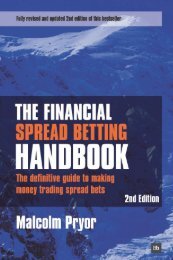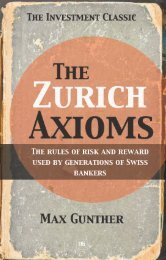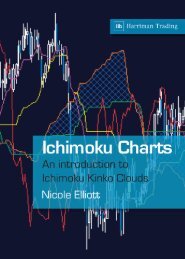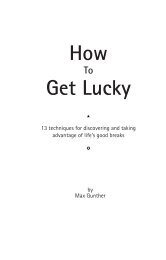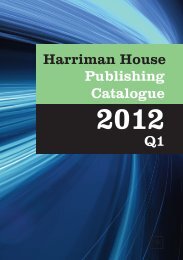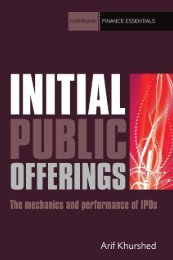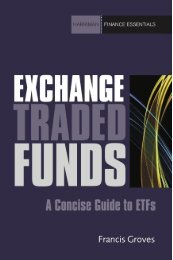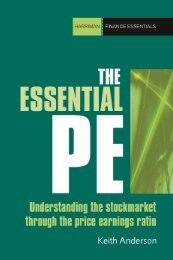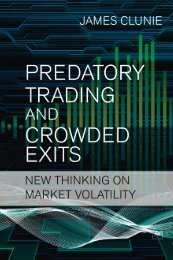xxxxx 1 - Harriman House
xxxxx 1 - Harriman House
xxxxx 1 - Harriman House
Create successful ePaper yourself
Turn your PDF publications into a flip-book with our unique Google optimized e-Paper software.
<strong>xxxxx</strong><br />
1
• • • • Sample • • • •
How to Build a<br />
Share Portfolio<br />
A practical guide to selecting and<br />
monitoring a portfolio of shares<br />
Rodney Hobson<br />
Hh
HARRIMAN HOUSE LTD<br />
3A Penns Road<br />
Petersfield<br />
Hampshire<br />
GU32 2EW<br />
GREAT BRITAIN<br />
Tel: +44 (0)1730 233870<br />
Fax: +44 (0)1730 233880<br />
Email: enquiries@harriman-house.com<br />
Website: www.harriman-house.com<br />
First published in Great Britain in 2011<br />
Copyright © <strong>Harriman</strong> <strong>House</strong> Ltd<br />
The right of Rodney Hobson to be identified as Author has been asserted in accordance<br />
with the Copyright, Design and Patents Act 1988.<br />
ISBN: 978-0857190-21-5<br />
British Library Cataloguing in Publication Data<br />
A CIP catalogue record for this book can be obtained from the British Library.<br />
All rights reserved; no part of this publication may be reproduced, stored in a retrieval<br />
system, or transmitted in any form or by any means, electronic, mechanical,<br />
photocopying, recording, or otherwise without the prior written permission of the<br />
Publisher. This book may not be lent, resold, hired out or otherwise disposed of<br />
by way of trade in any form of binding or cover other than that in which it is published<br />
without the prior written consent of the Publisher.<br />
Printed and bound by the CPI Group, Antony Rowe, Chippenham.<br />
No responsibility for loss occasioned to any person or corporate body acting or<br />
refraining to act as a result of reading material in this book can be accepted by the<br />
Publisher or by the Author.
Disclaimer<br />
All the many case studies included in this book refer to genuine<br />
announcements and events on the London Stock Exchange. However,<br />
they represent the situation at each company referred to at a given<br />
moment in time. Circumstances change and issues raised at one<br />
juncture may be resolved or superseded. Similarly, new challenges<br />
arise over time.<br />
Therefore nothing in this book constitutes a recommendation to buy<br />
or sell shares in a specific company or sector. The sample portfolio is<br />
for illustrative purposes only. Investors must exercise their own<br />
judgement.<br />
Readers interested in finding out more about a particular company<br />
should read the latest stock market announcements.<br />
At the time of writing the author held shares in Royal Dutch Shell,<br />
National Grid and Hornby but not in any other company mentioned<br />
in this book. These investments were being held for the long term.<br />
There is also reference to tobacco companies. For the record, the<br />
author has never smoked.<br />
iii
About the author<br />
Rodney Hobson is an experienced financial journalist who has held<br />
senior editorial positions with publications in the UK and Asia.<br />
Among posts he has held are news editor for the business section of<br />
The Times, editor of Shares magazine, business editor of the<br />
Singapore Monitor and deputy business editor of the Far Eastern<br />
Economic Review.<br />
He has also contributed to the City pages of the Daily Mail, The<br />
Independent and The Independent on Sunday.<br />
Rodney was at the forefront in the setting up of financial websites,<br />
firstly as Head of News for the launch of Citywire and more recently<br />
as Editor of Hemscott, for whom he continues to write a weekly<br />
investment email. He has been featured on BBC TV and radio and<br />
on CNBC, as well as appearing as a guest speaker at conferences such<br />
as the World Money Show.<br />
He is the author of Shares Made Simple, the authoritative beginner’s<br />
guide to the stock market, Small Companies, Big Profits, a guide to<br />
investing in smaller quoted companies, and Understanding Company<br />
News, the guide to interpreting stock market announcements. All are<br />
published by <strong>Harriman</strong> <strong>House</strong>.<br />
Rodney is registered as a representative with the Financial Services<br />
Authority. He is married with one daughter.<br />
Other books by the same author:<br />
www.harriman-house.com/sharesmadesimple<br />
www.harriman-house.com/smallcompanies<br />
www.harriman-house.com/understandingcompanynews<br />
Rodney Hobson’s personal website is www.rodneyhobson.co.uk<br />
v
Contents<br />
Preface<br />
Introduction<br />
xi<br />
xv<br />
Part I – The Choice of Assets 1<br />
Chapter 1. The Range of Assets 3<br />
What is a portfolio? 3<br />
Shares 5<br />
Cash 6<br />
Gold 7<br />
Gilts 10<br />
Company bonds 11<br />
Property 12<br />
Works of art 13<br />
Collectibles 13<br />
Funds 14<br />
Exchange Traded Funds 15<br />
Summary comparison of assets 18<br />
Costs 19<br />
Mix and match 20<br />
Why build a properly constructed portfolio? 21<br />
Lessons learnt 22<br />
Chapter 2. The Attractions of Equities 23<br />
Performance 23<br />
Diversification 26<br />
Foreign stocks 28<br />
Lessons learnt 34<br />
Part II – Building a Portfolio 35<br />
Chapter 3. Basic Decisions 37<br />
Investing for income 37<br />
Investing for growth 38<br />
vii
How to Build a Share Portfolio<br />
How many? 39<br />
Pounds, not numbers 41<br />
Sectors 41<br />
Weightings 42<br />
Over and under weight 45<br />
Lessons learnt 46<br />
Chapter 4. Top Down and Bottom Up 47<br />
Top down 47<br />
Bottom up 52<br />
Best of both worlds 57<br />
Chapter 5. Fundamentals 59<br />
What to look for 60<br />
Company analysis 61<br />
Lessons learnt 75<br />
Chapter 6. Choosing Between Cyclicals and Defensives 77<br />
Timing issues 79<br />
Visibility of earnings 81<br />
Cyclicals 82<br />
Defensives 89<br />
Lessons learnt 98<br />
Chapter 7. Investing for Dividends 99<br />
Where to look for dividends 107<br />
Dividend cuts 110<br />
High payers 112<br />
Dividends in dollars 112<br />
Lessons learnt 113<br />
Chapter 8. Investing for Capital Growth 115<br />
Growth companies 116<br />
Value investing 117<br />
Case Study: Dogs of the Dow 118<br />
Lessons learnt 122<br />
viii
Contents<br />
Chapter 9. When to Invest 123<br />
Bull or bear market 123<br />
Volatile markets 124<br />
Buying opportunities 124<br />
Pound cost averaging 129<br />
Lessons learnt 130<br />
Chapter 10. New Issues 131<br />
Taken on merit 133<br />
Pricing 133<br />
Book building 134<br />
Lessons learnt 139<br />
Chapter 11. When Share Prices Fall 141<br />
Catching falling knives 147<br />
Profit warnings 149<br />
Lessons learnt 151<br />
Part III – Managing Your Portfolio 153<br />
Chapter 12. Monitoring Your Portfolio 155<br />
How often to monitor 157<br />
Measuring performance 158<br />
Benefits of monitoring 162<br />
Chapter 13. Stop Losses and Averaging Down 165<br />
Stop losses 165<br />
Averaging down 172<br />
Lessons learnt 175<br />
Chapter 14. Adding to Existing Holdings 177<br />
Changes in circumstances 178<br />
Lessons learnt 180<br />
Chapter 15. Selling Existing Holdings 181<br />
Keeping calm 186<br />
Tracking news announcements 190<br />
ix
How to Build a Share Portfolio<br />
Taking some profits 201<br />
Lessons learnt 202<br />
Chapter 16. Rights Issues and Placings 203<br />
Right issues 203<br />
Grandiose schemes 209<br />
Rights issues at or near the market price 213<br />
Placings and open offers 213<br />
Special dividends and share buybacks 214<br />
Lessons learnt 216<br />
Chapter 17. Takeovers and Demergers 217<br />
Takeovers 217<br />
Demergers 224<br />
Lessons learnt 228<br />
Chapter 18. Costs and Taxes 229<br />
Costs 229<br />
Taxes 232<br />
Chapter 19. An Example Portfolio 239<br />
Shares bought 240<br />
Portfolio valuation (at start) 242<br />
Dividends received 243<br />
Issues faced 243<br />
Lessons learnt 247<br />
Index 249<br />
x
Preface<br />
Who this book is for<br />
Anyone who is thinking of investing, however much or however little,<br />
will benefit from the information, advice and guidance contained in<br />
these pages. Similarly those who already have a portfolio will find it<br />
helpful to stand back and assess whether they are making the most<br />
of their money and whether their portfolio is meeting their needs.<br />
Many investors simply pick shares that take their fancy, or perhaps<br />
ones that have been recommenced in the financial press, without any<br />
thought for whether their selections create a suitable or balanced<br />
portfolio.<br />
They then cling on to their purchases irrespective of whether their<br />
investment needs have changed or whether the companies they chose<br />
still meet their investment objectives.<br />
This book explains in simple terms the criteria for picking shares,<br />
and for deciding which companies to retain and which to dump.<br />
It is written in a clear, easy to follow style that will suit beginners and<br />
more experienced investors alike. It is packed with real case studies<br />
taken from actual stock market events and developments to illustrate<br />
the key points.<br />
What this book covers<br />
We are interested primarily in building and maintaining a portfolio<br />
of UK company shares.<br />
These are not the only assets we may want to invest in and one of<br />
the recurring themes of this book is the merit of spreading<br />
investments to maximise our opportunities and minimise the risk of<br />
heavy losses.<br />
We do look at other types of asset: Some, such as exchange traded<br />
funds and company bonds that are linked to the stock market, and<br />
xi
How to Build a Share Portfolio<br />
others, such as commodities and property, that have their own<br />
economic cycles.<br />
However, these assets are considered additions to a well-run share<br />
portfolio, with the investor taking a view on what they offer by way<br />
of diversifying risks. We consider the different risks and rewards that<br />
they offer compared with shares.<br />
We also look briefly at the possibility of investing in overseas<br />
companies, either on the London Stock Exchange or on a foreign<br />
exchange such as New York or Tokyo.<br />
The main thrust of this book, though, is investment in UK companies<br />
through the London stock market. This is an area that UK investors<br />
will be most familiar with and more comfortable with, where reliable<br />
information and knowledgeable analysis are most freely available.<br />
We consider the different attitudes that investors should have,<br />
depending on whether they are investing for income or for growth,<br />
and help you decide which is right for you.<br />
How this book is structured<br />
The book is divided into three sections. Listed below are the three<br />
sections and the major topics covered within each section.<br />
Part I: The choice of assets<br />
• What types of asset are available to invest in<br />
• The merits and pitfalls of various assets<br />
• How to choose which assets suit you<br />
• The importance of equities in any portfolio<br />
xii
Preface<br />
Part II: Building a portfolio<br />
• Deciding what you want from your portfolio<br />
• Income versus growth<br />
• Why you should diversify<br />
• How to select shares<br />
• How to choose between cyclical and defensive stocks<br />
• How big a portfolio should you hold?<br />
Part III: Managing your portfolio<br />
• Monitoring your portfolio<br />
• Active trading and investing for the long term<br />
• Stop losses and share price averaging<br />
• Rebalancing your portfolio<br />
• Corporate actions: rights issues and takeovers<br />
• Mitigating tax liabilities<br />
Supporting website<br />
The accompanying website for this book can be found at:<br />
www.harriman-house.com/howtobuildashareportfolio<br />
xiii
Introduction<br />
When I wrote to a friend that I was writing books on stock market<br />
investing, he wrote back to say: “I hope you advise people to put<br />
their money under the mattress.”<br />
No, I do not!<br />
Putting your money under the mattress is just plain stupid. Your cash<br />
deteriorates as inflation gnaws at its value – and you risk losing the<br />
lot if you are burgled. Even if you escaped the attentions of the<br />
criminal fraternity for 50 years or so, £1000 cash stuffed under the<br />
mattress in 1960 would be worth less than £60 at today’s prices.<br />
The only time that holding banknotes and coins would be worthwhile<br />
is in a prolonged period of deflation, when the amount of goods they<br />
could buy would increase. Since governments believe that modest<br />
inflation of 2-3% is good for the economy, we are not likely to see<br />
cash heaven in our lifetimes.<br />
Stashing large amounts of money away in a savings account bearing<br />
near to zero interest is not much better. Again your cash loses value<br />
over time; and the bailout of banks around the world during the<br />
credit crisis demonstrates that even this form of investment is not<br />
entirely risk free.<br />
There is a wide range of investments that offer income, capital gains,<br />
or both. Yes, they do carry some risks but, as we shall see, risk can<br />
be managed and minimised.<br />
We shall also see that a sensibly constructed portfolio of shares in<br />
companies quoted on a reliable stock market such as the London<br />
Stock Exchange offers the best rewards combined with the least risk.<br />
Prepare to get that cash out from under the mattress.<br />
xv
Part I<br />
The Choice of Assets
Chapter 1.<br />
The Range of Assets<br />
What is a portfolio?<br />
Let us start by defining what a portfolio is. We are talking about a<br />
range of investments held by one person or perhaps by a group of<br />
individuals such as a family or an investment club.<br />
A portfolio investor thinks primarily about the total value of his<br />
portfolio (in a wider sense, we might call this his wealth). This may<br />
sound obvious, but it’s a fact that many investors focus more on the<br />
success or failure of individual stocks rather than their total portfolio<br />
performance. It is, after all, very easy to dwell on the stock that rose<br />
200% – or fell 90%. But in portfolio terms, these are secondary<br />
matters; it is the total portfolio value that is of prime importance.<br />
And this requires us to approach investing in a different way than<br />
just becoming obsessed with picking a winner every time.<br />
So, the stocks we add to our portfolio are not just any old investments<br />
slung together from a range of privatisations or tips we’ve seen in<br />
Sunday newspapers. We are considering a sensible, disciplined<br />
approach in systematically assembling a range of assets that meet the<br />
criteria that we set for ourselves – criteria that balance the expected<br />
risks and rewards of our investments.<br />
This is not a complicated procedure and you don’t need a degree in<br />
mathematics to do it. Nor does it have to occupy every waking hour.<br />
Most of it is common sense and knowing what you want out of life.<br />
No two people would look for exactly the same portfolio and a<br />
portfolio assembled in your twenties would not be the same as one<br />
that meets your desires in retirement.<br />
3
How to Build a Share Portfolio<br />
Building and maintaining a portfolio involves:<br />
• selecting assets appropriate to your requirements<br />
• deciding how much of each asset to buy<br />
• striking and maintaining a balance<br />
• setting targets for the performance of your portfolio<br />
• measuring the portfolio’s performance against a benchmark such<br />
as the FTSE index.<br />
Questions to ask before you start<br />
But there are important questions you must ask yourself before you<br />
consider any kind of investment.<br />
First, write down in one column all your household’s monthly income<br />
and in a second column your total monthly expenditure, including<br />
any mortgage payments, utility bills, average credit card bills and so<br />
on. This will give you a clear idea of your finances and how much<br />
you can comfortably invest.<br />
Now, the questions:<br />
• Do you own your home?<br />
This should probably be your first investment, if you have the<br />
initial deposit that gets you on the housing ladder. You have to<br />
live somewhere and houses tend to rise in value over time.<br />
• Do you have some cash that you can get at easily in an<br />
emergency?<br />
If you tie up all your money in investments you may find yourself<br />
scrambling to sell assets at unfavourable prices, so do keep<br />
something by for a rainy day.<br />
• Are you looking primarily for capital growth or income?<br />
• How long do you want to lock your capital away for?<br />
• How averse are you to taking risks?<br />
4
1. The Range of Assets<br />
These are questions that only you can answer.<br />
Even if you invest through a financial adviser or pay for advice from<br />
your stockbroker, only you know how you feel in your heart of<br />
hearts. No investment is worth having sleepless nights over.<br />
If you do have cash to invest, though, there is a wide range of<br />
investments available to you. This book argues that a sound portfolio<br />
of equities is the best option, although there is absolutely no reason<br />
why investors should not widen their portfolios to include other<br />
forms of investment. After all, variety is a way of spreading risk.<br />
While this book is primarily about building a share portfolio, it is<br />
worth quickly taking a look at the alternatives. In doing so we may<br />
come to a greater appreciation of the merits of shares as an investment<br />
and, perhaps, decide that sticking with shares is the soundest policy.<br />
Let’s start by considering the various asset classes that are readily<br />
available.<br />
Shares<br />
We will look at shares in detail in the following chapter, so here I will<br />
just make a few quick points.<br />
Quite simply, no other investment offers you the many advantages<br />
you will find in holding a portfolio of shares; no other investment<br />
provides the combination of income and capital gains that shares do.<br />
Shares in sound, profitable companies will gain value over time and<br />
dividends will increase, so your capital and your income both rise to<br />
beat inflation.<br />
No other investment offers you the sheer variety that shares do. You<br />
can:<br />
• buy for the short, medium or long term, or build a mixture of all<br />
three, and change your mind whenever you want<br />
• stick to dull but safe companies or chance your arm with high<br />
fliers<br />
5
How to Build a Share Portfolio<br />
• collect a range of varied companies so you stand to gain whatever<br />
the economic circumstances<br />
• take advantage of concessions on income, capital gains and<br />
inheritance taxes<br />
• enjoy perks for shareholders in a range of companies including<br />
travel, retail and even housebuilding<br />
• easily check how your investments are faring in your daily<br />
newspaper or online<br />
• invest at home or abroad, and pick foreign stocks through the<br />
London Stock Exchange<br />
• choose investments in developed, growing and emerging<br />
economies<br />
• trade on well regulated, orderly stock markets.<br />
It is true that, as the old mantra puts it, shares can go down as well<br />
as up. Companies can and do go bust. What is more, dividends on<br />
ordinary shares can be reduced or scrapped in tough times.<br />
The answer is to spread your investments across a range of shares in<br />
different sectors so that one bad apple does not ruin the harvest.<br />
Cash<br />
The judicious use of a cash pile has its merits:<br />
• It will normally earn interest, however little, when deposited with<br />
a bank or building society and you can choose whether to have<br />
instant access to it or tie it up for a longer period in return for<br />
extra interest. At least you are getting some return.<br />
• Getting some return on your cash will make you feel more<br />
comfortable with staying out of the stock market when you<br />
cannot see a worthwhile company to invest in. During a bear<br />
market you may wish to stay out of shares until the market settles.<br />
During a bull run you may wish to take profits and wait to buy<br />
back at lower levels.<br />
6
1. The Range of Assets<br />
• It provides you with a source of instant funds if you suddenly<br />
incur a hefty expense, avoiding the need to cash in shares or other<br />
assets when it may not be convenient to do so.<br />
Many people of all ages think that money in a deposit account at the<br />
bank is safer than investing in shares. Yet the opposite is nearer to<br />
the truth.<br />
Your savings deposit gradually loses value as it is eroded by inflation.<br />
You may be able to live off the interest now but that interest will be<br />
worth less and less as inflation reduces the real value of the pound.<br />
When interest rates are high, so too is inflation, so your deposit is<br />
being washed away at alarming speed; when inflation is low your<br />
savings retain their value for longer but the interest is reduced, as<br />
many pensioners discovered after the Bank of England slashed its<br />
base rate to just 0.5%, with banks reducing the rates for savers to as<br />
little as 0.1%.<br />
Gold<br />
The precious metal is an unusual form of investment for many<br />
reasons, not least that it is dug from the ground at considerable<br />
expense, refined at further expense, moulded into ingots again at a<br />
cost and then buried back underground in bank vaults, where it is<br />
stored at more expense in security and insurance premiums.<br />
In practical terms it is pretty useless as a store of wealth because of<br />
its sheer weight, as you cannot take it with you if your cache is under<br />
threat. Mind you, it is hard to steal for the same reason.<br />
The more highly refined it is, the more value it has as a store of<br />
wealth. However, gold is also used in jewellery and dentistry, for<br />
instance, where its value increases if it is of lower purity because the<br />
metal is very soft and wears away easily.<br />
A little gold can go a remarkably long way, as any user of gold leaf<br />
will tell you. Yet a small amount will weigh more than you can carry.<br />
7
How to Build a Share Portfolio<br />
No wonder kings and commoners have been fascinated by this weird<br />
and wonderful element since time immemorial.<br />
The gold standard<br />
For many years gold was used to determine the value of currencies,<br />
initially because coins were minted from it and then because each<br />
currency was valued against one ounce of gold – the gold standard.<br />
In the 1940s and 50s the price of gold was fixed at $34 an ounce,<br />
but the dollar came under pressure in the 1960s as speculators<br />
realised that the US government did not have enough reserves to<br />
maintain the formal link. Gold was re-valued up to $35, then $38,<br />
then $44 an ounce before the price was allowed to float in 1973.<br />
The freeing of the dollar from the gold standard has distorted the<br />
price of gold over the period since. Initially, gold soared to $850 in<br />
1980 as the buying frenzy fed on itself. Then it collapsed below $400<br />
as demand was sated and the metal fell out of fashion as an<br />
investment must-have.<br />
The 20 years marking the end of the millennium were particularly<br />
disappointing for gold addicts. Eventually the price bottomed at $295<br />
in January 2000.<br />
Since 2000, gold has come back into fashion with investors. The<br />
three-year bear market for shares that greeted the turn of the century,<br />
the sight of planes crashing into the Twin Towers in New York, the<br />
war to oust Saddam Hussein that sucked the US and UK into long<br />
years of attrition in Iraq and Afghanistan and the sub-prime scandal<br />
that precipitated banking collapses and the credit crunch all sent<br />
nervous investors into a search for a safe haven.<br />
The precious metal topped $1000 an ounce in 2009 and reached a<br />
peak just above $1200 in December that year. While the momentum<br />
was maintained, the talk was not of taking substantial profits but of<br />
the price reaching $1500.<br />
8
1. The Range of Assets<br />
Figure 1.1: Price of gold (1968-2010)<br />
US$<br />
Gold has two aspects to its price<br />
Firstly, there is the truly commercial value set by supply and demand.<br />
Gold miners produce the stuff and end users make necklaces, false<br />
teeth and the like. As with any commodity, if production outstrips<br />
demand, the price will fall; if production falls short of demand then<br />
the price will rise.<br />
About 70% of the world’s gold is used in jewellery so this is an<br />
important factor in keeping up the price of gold. It costs more than<br />
$400 an ounce to mine gold. If the price drops below this level,<br />
mining it will not be economically worthwhile and supply will<br />
dwindle until the price rises again.<br />
Secondly, there is the (possibly conflicting) pull of sentiment. Gold is<br />
traditionally seen as a safe haven in times of conflict or uncertainty<br />
in the currency market. Tension in the Middle East or a run on the<br />
dollar sends the price of gold soaring, while peaceful periods ease the<br />
pressure on the gold price.<br />
Another factor, though, has come into play in recent years. Investing<br />
in gold has become fashionable again. The price has risen slowly but<br />
9
How to Build a Share Portfolio<br />
surely over several years, each dollar on the price serving to persuade<br />
new and existing investors that it is a solid investment where you<br />
cannot lose if you hold on for the long term.<br />
Such an impression is, however, flawed. There are clear disadvantages<br />
in investing in gold.<br />
• There is just one type of gold, so you cannot spread the risk as<br />
you can with shares. It is true that you could buy gold coins rather<br />
than ingots but the value will move in the same direction whatever<br />
form of gold you buy.<br />
• The price of gold could drop back as quickly as it has risen if it<br />
falls out of favour. The price has in fact been quite volatile over<br />
time.<br />
• It pays no dividend, as companies do to shareholders. Your only<br />
possible gain is a capital gain from a rising price.<br />
• You are unlikely to want to keep a store of gold locked in your<br />
house. If you did take physical delivery of the stuff you would<br />
have to insure it, which eats away at your capital.<br />
There is a sensible alternative to buying gold direct and that is to<br />
invest in a fund that specialises in gold by buying the metal itself or<br />
holding shares in companies involved in precious metals.<br />
Gilts<br />
Gilt-edged securities are bonds issued by the government. They hold<br />
two major attractions: they are relatively safe and there is a wide<br />
variety to choose from.<br />
Since they are issued by the government, gilts are seen as the safest<br />
form of investment in the UK because, after all, if the government<br />
goes bust then we are all up the creek anyway.<br />
As with shares, however, the value of gilts can fall as well as rise. In<br />
times of rising interest rates, the price of gilts falls to give, in effect,<br />
10
1. The Range of Assets<br />
a higher rate on each £100 invested, while if interest rates fall the<br />
price of gilts rises.<br />
A disadvantage of gilts compared with shares is that, with the<br />
exception of a handful of government bonds that are linked to the<br />
rate of inflation, the interest rate is fixed so there is no prospect of<br />
seeing your income increase year by year. Also capital gains are<br />
limited because gilts have a fixed redemption price – or no<br />
redemption price at all in the case of undated gilts.<br />
It is possible to buy bonds issued by foreign governments but this can<br />
be dangerous. Argentina defaulted on $100 billion worth of debt in<br />
December 2001. It was not the first time that a Latin American<br />
country had defaulted, nor even the first time that Argentina had,<br />
but it was the most spectacular. More recently the credit crunch crisis<br />
cast doubts over the sovereign debt of Greece and other<br />
Mediterranean countries.<br />
Investors should bear in mind that gilt purchases work extremely well<br />
if you buy at the top of the interest rate cycle because you have locked<br />
in a good rate of interest and stand to make a capital gain on top.<br />
You are doomed to disappointment if you buy gilts just before<br />
interest rates start to rise because the value of your holding will fall.<br />
Gilts are traded on a liquid market so there is no difficulty in buying<br />
and selling them. If you choose to hold gilts alongside a shares<br />
portfolio you are providing yourself with a known level of income<br />
to offset the less certain payment of company dividends, which can<br />
be reduced in hard times.<br />
Summary: gilts are attractive when interest rates are high, which is<br />
when shares tend to be out of favour.<br />
Company bonds<br />
These have the same characteristics as gilts except that they are issued<br />
by companies rather than the government. They are thus seen as<br />
carrying a higher risk of default than gilts and they will carry a higher<br />
interest rate to compensate.<br />
11
How to Build a Share Portfolio<br />
The larger and more secure the company, the smaller the interest rate<br />
gap will be over gilts.<br />
Bonds do represent an alternative way of investing in sound<br />
companies but you do not own a stake in the company as you do<br />
with shares. Also the interest rate is static while you hope that<br />
dividends on shares will rise over time.<br />
Property<br />
Buy-to-let became highly popular before the credit crunch. It was<br />
fuelled in particular by loans from Bradford & Bingley – one of the<br />
many building societies that turned into a bank and needed to find a<br />
niche within the financial sector. Bradford & Bingley had issued a<br />
quarter of the one million buy-to-let mortgages in operation when<br />
the UK housing market collapsed in the first half of 2008.<br />
While there is much merit in buying your own home, since you have<br />
to live somewhere and you might as well pay the rent money into a<br />
mortgage instead, buying houses and flats to rent out is not such a<br />
clear cut winner as was supposed.<br />
The main drawback of investing in property is that you need a fair<br />
chunk of cash, even assuming that you can get a mortgage to cover<br />
most of the cost. You will also be taxed on the income from your<br />
investment and on any capital gains you make when you sell.<br />
And there is another problem: it may be difficult to sell if you want<br />
to cash in your investment. There may not be a ready supply of<br />
buyers falling over themselves to buy you out.<br />
Finding the right tenant also presents difficulties. You need to buy in<br />
an area where people want to rent, which may not be where you<br />
would want to own property. Any damage to property or furnishings<br />
is likely to come out of your pocket and the tenants may prove unable<br />
or unwilling to pay the rent, in which case it is expensive and time<br />
consuming to evict them.<br />
12
1. The Range of Assets<br />
On the other hand, property does tend to offer one of the virtues of<br />
shares: if all goes well you enjoy income while the value of your<br />
investment rises to offset inflation. If you are unlucky and the value<br />
of your investment falls then at least you have had some income as<br />
compensation along the way and you will not lose everything, unless<br />
the house falls down.<br />
Works of art<br />
This is another area that has moved in and out of fashion. It is true<br />
that valuable paintings, sculpture and the like can appreciate heavily<br />
in value; but you really do have to be an expert to do well.<br />
Disadvantages include the cost of insurance, the vagaries of the<br />
market place and the substantial commissions that auction houses<br />
charge. If you buy and sell at auction you will find that prices for<br />
similar objects can vary enormously according to whether there are<br />
competing bids.<br />
Collectibles<br />
The popularity of TV programmes featuring people who have found<br />
valuable items in the loft or at a car boot sale and sold them for a<br />
small fortune has alerted investors to the possibility of establishing<br />
collections of Dinky toys, cigarette cards and Giles annuals to be sold<br />
on to avid enthusiasts.<br />
The emergence of auction websites such as eBay has made trading<br />
easier and more popular. Online auctions are cheaper than salerooms<br />
and you are more likely to drum up a competitive auction.<br />
Postage stamps and coins are perennially popular, though most<br />
people grow out of this childhood phase. It can admittedly be a<br />
lucrative pastime. According to Stanley Gibbons, the most famous<br />
name in stamp collecting, stamps increased in value at a compound<br />
annual rate of 13.2% over the ten years from 1998 to 2008, rising<br />
in value even after the start of the credit crunch.<br />
13
How to Build a Share Portfolio<br />
There was, however, no reason to believe that such strong growth<br />
would continue: this was one case of believing that the past is no<br />
guide to the future. Indeed, the faster an asset of this type has risen<br />
in the recent past, the more reason there is to think that a correction<br />
is imminent.<br />
Collectible items have no value in themselves. They do not make<br />
profits as companies do and thus depend entirely on new collectors<br />
joining in. Many collectors become sentimentally attached to their<br />
wares, so that far from cashing in profits they simply hang on<br />
irrespective of how the market is doing.<br />
Tastes change and this year’s fad may not be in demand next year.<br />
Also you are likely to be spending considerable time scouring boot<br />
sales and charity shops with limited success.<br />
Funds<br />
It is not necessary to assume the whole burden of selecting shares<br />
onto your own shoulders if you are not confident. Most banks offer<br />
ISA investments that put your money into funds investing in the stock<br />
market. Most popular are the ones that buy shares in the FTSE 100<br />
index comprising the 100 largest companies listed on the London<br />
Stock Exchange as these are seen in the main as safe, solid enterprises.<br />
Such multi-million pound funds can spread your money across a<br />
much wider range of shares than you could achieve yourself with<br />
your modest assets and thus are correspondingly safer.<br />
Some funds are permanently available while others have a short<br />
period in which you can subscribe and are then closed. Ask your bank<br />
what is available or ask to see an investment adviser. Remember that<br />
you do not have to go to the bank where you have your current<br />
account although you may be more comfortable doing so.<br />
Most likely the financial adviser will offer only the bank’s own<br />
products so the range will be limited. Don’t be afraid to ask if this is<br />
the case.<br />
14
1. The Range of Assets<br />
Make sure that the adviser fully understands what you want from<br />
your investments and what your attitude is to risk. The adviser needs<br />
to know your personal financial circumstances in order to offer you<br />
the best advice.<br />
There is no need to sign up on the spot. Take literature home with<br />
you and sleep on it. Read what you are given thoroughly and<br />
carefully and do not hesitate to ask about anything that troubles you.<br />
IFAs<br />
Alternatively you can invest through an independent financial adviser<br />
(IFA). As the name implies, the adviser works for him or herself and<br />
is not tied to just one range of financial products. The difficulty is<br />
finding one you feel comfortable with. Look for names under<br />
Financial Advisers in your local telephone directory. They will all be<br />
regulated by the Financial Services Authority. Ask your friends if they<br />
use an IFA whom they can recommend.<br />
IFAs earn a living by taking a commission from the funds that they<br />
put your money into. The advantage is that you get their services free<br />
but it does mean that they can be tempted to suggest those funds that<br />
pay them the highest commission. You can get round this by agreeing<br />
to pay the adviser a set fee out of your own money with any<br />
commission being added to your investment. Make sure the basis of<br />
payment for your IFA is clearly agreed right at the start.<br />
However, there is no reason why you should not invest in shares<br />
yourself if you follow a few simple rules. After all, you know your<br />
needs and aspirations better than anyone else ever could.<br />
Exchange Traded Funds<br />
New on the scene are Exchange Traded Funds (ETFs) which invest<br />
in a range of assets such as the FTSE 100, in a commodity such as<br />
platinum or soya beans, or in corporate bonds. The value of the funds<br />
rises or falls in line with the underlying asset.<br />
15
How to Build a Share Portfolio<br />
The funds are run by specialist companies in the same way as unit<br />
trusts or open-ended investment funds are, so there will be a<br />
management fee.<br />
The main advantages of ETFs are:<br />
• Very low costs<br />
• You can spread risks across a wide range of shares and<br />
commodities<br />
• They can be traded just like shares<br />
• They do not trade at a discount to the value of the assets as<br />
investment trusts tend to do.<br />
The fee will be lower than those charged by a conventional fund,<br />
typically around 0.35% which includes all expenses incurred in<br />
running the ETF. This is because ETFs are managed passively – the<br />
manager simply buys whatever investments are appropriate to the<br />
fund. With investment and unit trusts the manager is more active,<br />
attempting to buy the right shares at the right time to boost profits.<br />
ETFs are traded on the stock exchange just like ordinary shares. You<br />
can buy and sell at any time during stock market hours and prices<br />
are determined by supply and demand in exactly the same way as<br />
share prices. Pricing is thus more transparent than with unit trusts,<br />
where the price of units is set once a day by the manager.<br />
ETFs trade at the full aggregate value of their components, unlike<br />
investment trusts which usually trade at a discount of several<br />
percentage points to their underlying value.<br />
These funds allow investors to spread their cash over a wider field<br />
than would be possible buying single shares one or two at a time. If<br />
you buy a FTSE 100 tracker – the most popular ETF in the UK,<br />
accounting for more than 15% of ETF turnover – you have exposure<br />
to all the 100 top shares in the UK at one go.<br />
If events in the news are likely to affect a sector or a market, you can<br />
move swiftly in or out of a corresponding ETF accordingly.<br />
16
1. The Range of Assets<br />
They allow you to move into investments that you might otherwise<br />
have steered clear of, perhaps because you do not know enough<br />
about a particular type of investment or you do not know how to<br />
invest in it. Thus you are able to broaden your horizons with little<br />
risk.<br />
So, for example, if you wanted to invest in metals but did not know<br />
how to go about it you can simply buy an ETF investing in the metals<br />
you think will rise in price.<br />
Some ETFs allow you to ‘short’ the market, in other words to bet<br />
that values will fall. This is difficult for ordinary shareholders<br />
investing on the stock market.<br />
Global spread of ETFs<br />
ETFs have been particularly popular in the United States but have<br />
been slow to take off in the UK. You may find that there is not as<br />
wide a range of products or the depth of liquidity here as in the US.<br />
Nonetheless, the value of ETFs worldwide topped $1 trillion in 2009.<br />
Investors may need to check exactly what is in a fund before they<br />
subscribe. For example, an ETF covering emerging markets may not<br />
invest in all emerging markets and will almost certainly invest more<br />
heavily in some than others. So you could, for example, be buying<br />
into China when you think that India offers better prospects.<br />
Most ETFs traded on the London Stock Exchange are actually<br />
incorporated in Ireland and UK investors would not be eligible for<br />
the UK Financial Services Compensation Scheme, although it has to<br />
be said that the risk of default is very low.<br />
ETFs that invest in volatile markets carry a serious risk of losing you<br />
money and those with investments priced in foreign currencies carry<br />
an exchange rate risk. If the pound falls, that’s fine, but a rising pound<br />
would lower the value of your investment when translated back into<br />
sterling.<br />
17
How to Build a Share Portfolio<br />
Summary comparison of assets<br />
Table 1.1: The merits of rival investments<br />
Type of investment Advantages Disadvantages<br />
Bank or building society<br />
account<br />
Gilts<br />
Company bonds and<br />
preference shares<br />
Ordinary shares<br />
Investment and unit<br />
trusts<br />
Exchange Traded Funds<br />
Gold<br />
Works of art/collectibles<br />
Deposit remains intact<br />
and interest provides<br />
income.<br />
Backed by the<br />
government so minimal<br />
risk of default. Provide<br />
regular income.<br />
Provide income and take<br />
precedence over ordinary<br />
shareholders if the<br />
company gets into<br />
financial trouble.<br />
Solid companies will<br />
increase dividends,<br />
pushing the share price<br />
higher, so capital and<br />
income rise to offset<br />
inflation.<br />
Gives you wide spread of<br />
investments and you<br />
benefit from experienced<br />
manager’s expertise.<br />
Allow you to spread<br />
investments. Low<br />
management charges.<br />
Safe haven in a crisis;<br />
hedge against inflation.<br />
Can often be picked up<br />
cheaply and sold for a<br />
large profit.<br />
Value of investment is<br />
eroded by inflation and<br />
interest rates may fall.<br />
Capital is eroded by<br />
inflation and value of<br />
investment can fall.<br />
Do not share the benefits<br />
if the company does well.<br />
Capital is eroded by<br />
inflation.<br />
Investment is wiped out<br />
if the company goes<br />
bust. Dividends can be<br />
reduced.<br />
Management fees are<br />
deducted from your<br />
investment.<br />
Passive investment so<br />
you lose flexibility.<br />
Does not provide income;<br />
prices fluctuate.<br />
Do not provide income;<br />
selling can be expensive;<br />
fashions change.<br />
18
1. The Range of Assets<br />
Costs<br />
Every investment comes at a price and you must earn enough from<br />
the investment to cover those costs before you start to make a profit.<br />
Art<br />
The most expensive form of investment is operating through auction<br />
houses. These charge vendors anything from 8% to 20% of the sale<br />
price. To add insult to injury, VAT is charged on the commission at<br />
the current rate, which is 20% from 4 th January 2011, and there may<br />
be a small fee for putting an item into the auction irrespective of<br />
whether it is sold.<br />
The buyer will also usually be charged 10% on the sale price VAT<br />
on the commission. If you buy an item for £1000 you need to sell it<br />
for at least £1230, and possibly as much as £1450, just to break even.<br />
Using online auction sites is cheaper and you attract a potentially wider<br />
audience. For example, eBay has a sliding scale commission for buyers<br />
with a maximum of 5.25% plus a listing fee of no more than £2. You<br />
could buy and resell that £1000 item and make a profit at £1060.<br />
Equities<br />
In contrast, an online stock broker will execute an order to buy or<br />
sell shares for on average £12.50 per trade and in some cases for as<br />
little as £10 a time. Thus a £1000 share purchase will cost £10 plus<br />
0.5% stamp duty of £5, Selling some time later at a cost of £10 makes<br />
a total cost of £25, so you need to sell your £1000 investment for<br />
£1025 to break even.<br />
However, the bonus with a share portfolio is that if your £1000<br />
worth of shares pays a dividend of £25 while you hold them, then<br />
you have covered your costs anyway.<br />
These figures are particularly important the more actively you trade,<br />
since you will be running up costs several times over. For example, if<br />
19
How to Build a Share Portfolio<br />
you buy and sell a £1000 investment once a month for a year, the<br />
total cost will be around £300 (12 x £25) – which is a big chunk of<br />
the £1000 investment.<br />
Gilts and bonds<br />
Buying and selling gilts or company bonds can also be carried out<br />
through your broker at a similar flat rate fee.<br />
If you choose to receive advice from your broker you will find<br />
yourself paying 1% to 3% of the value of your share trades as a fee<br />
and you will probably be required to carry out a minimum number<br />
of transactions.<br />
Property<br />
Costs of other types of investment vary enormously. Buying property<br />
will involve solicitor’s fees of several hundred pounds, plus your<br />
mortgage lender’s fees if you need to borrow money, plus stamp duty<br />
from 1% to 5% depending on the value of the property. Any rent<br />
received will have to cover mortgage repayments and repair and<br />
maintenance bills. When you sell there will be estate agents’ bills.<br />
The important point is that you should check what the costs will be<br />
with the broker/auctioneer/estate agent before you rush in, and you<br />
should be satisfied that you can cover them.<br />
Mix and match<br />
We have noted that different asset classes have different attributes<br />
and drawbacks. There is no reason why you should not combine two<br />
or more of them if that suits your investment needs. For instance, you<br />
could invest in a tracker fund for safety and stability while running<br />
your own share portfolio. At least you would then know whether<br />
you were as good as the professionals!<br />
You may fancy your chances as a property landlord but not want to<br />
put all your eggs into this basket. You could buy one property to see<br />
20
1. The Range of Assets<br />
how it works out and put the rest of your surplus cash into dividendpaying<br />
shares. Cash from the dividends could help to tide you over<br />
if you have a period without a tenant.<br />
Why build a properly constructed portfolio?<br />
So, you have decided to invest, but perhaps you are wondering why<br />
you should bother putting together a structured portfolio. Why not<br />
just buy whatever takes your fancy?<br />
No-one is stopping you. If your instincts are good and you can spot<br />
a winner when you see one, by all means go ahead and follow your<br />
nose. Best of luck.<br />
You will certainly need luck, however good you are as a tipster. You<br />
will end up with investments that may or may not meet your needs.<br />
You will almost certainly overload your portfolio with too many<br />
companies from one sector as each initial success prompts you to<br />
choose more of the same. You are also likely to overstretch your<br />
finances as you pile in merrily whenever you spot the next racing<br />
certainty.<br />
This is the mind of a gambler, not an investor.<br />
Alternatively, you may want to go to the other extreme. Fearing your<br />
propensity to make poor choices, you could opt to put your savings<br />
into a fund such as a unit or investment trust.<br />
This again is a perfectly legitimate investment strategy, though an<br />
ultra-cautious one. You do at least have some choice between funds<br />
that invest for income and those that invest for capital gains.<br />
However, you are entirely in the hands of the fund manager and have<br />
no say in the investment decisions.<br />
Tracker funds are an especially useful way for beginners to get into<br />
the habit of stock market investing and if you are nervous why not<br />
run a tracker fund alongside your own investment portfolio? This is,<br />
a strategy that many experienced investors follow.<br />
21
How to Build a Share Portfolio<br />
Lessons learnt<br />
You need to do a bit of serious thinking before you start to invest:<br />
• How much can I really afford to invest?<br />
• What do I want at this stage in my life?<br />
• What investment or investments best meet those needs?<br />
You should consider equities as your preferred choice, either on their<br />
own or in tandem with other asset classes, because:<br />
• They are comparatively cheap to buy and to hold<br />
• They offer the prospect of income and capital gains<br />
• They are in the main traded on properly regulated exchanges.<br />
Now it is time to start building your portfolio.<br />
22
How to Build a Share<br />
Portfolio<br />
A practical guide to selecting and monitoring a<br />
portfolio of shares<br />
Rodney Hobson<br />
Available direct from <strong>Harriman</strong> <strong>House</strong> and all good booksellers. To order<br />
a copy of the print or ebook edition go to:<br />
www.harriman-house.com/howtobuildashareportfolio<br />
Paperback: 9780857190215<br />
eBook: 9780857191236



